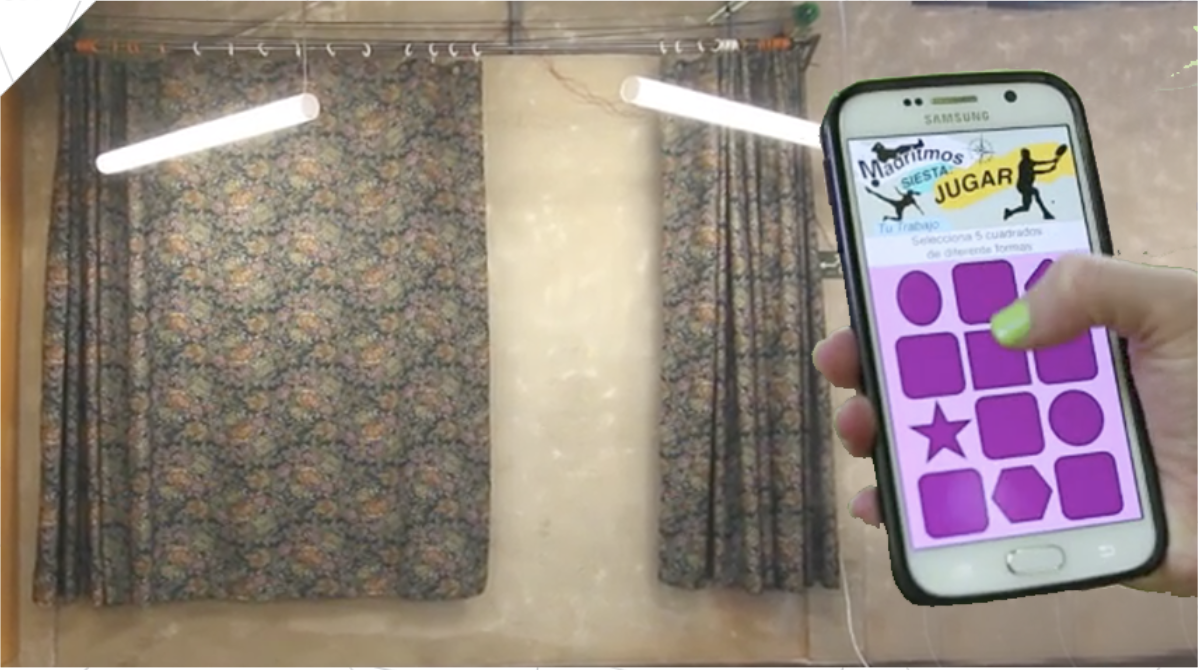SEE PROJECT VIDEO DOCUMENTATION HERE: https://vimeo.com/174589509
“Madritmos” (“Mad”: Madrid “ritmos”: Algorithms) is an interactive digital, kinetic, geo-location performance project, that uses algorithmic functions calculated in a custom GPS Tracking Android Phone App to direct the user’s or “passengers,” to move around the city of Madrid, Spain. Influenced by the French Situationists who experimented with numerous rules for navigating Paris with the intention of breaking from routine to re-experience Paris from new perspectives, “Madridritmos” will use a custom phone app that, when shaken, will guide the “passengers” through the city of Madrid, with directions and distances as well as required activities, such as sampling cuisine or asking the nearest person their name, and then shaking the phone again for the next directive. Directives are intended to guide the user/passenger through the city exposing elements of navigational chance. The movements of the user/passenger will be tracked via GPS and used to control the movements an automated kinetic interactive tapestry-style curtain in one of the large foyer windows in the entrance of the Medialab Prado. A small gap in the two sided curtain will seem to be tracking, moving left and right, revealing the perspective location from the point of the viewer to the point of the user/participant that is out navigating the Madrid.
At moments while navigating Madrid, a “siesta”-based directive will appear on the user/passenger’s phone screen directing them to “sleep,” “dance,” “sing,” “eat,” “drink,” “love” or other. These phone app directives will simultaneously trigger the curtain to animate with familiar associative gestures to the directives, along with associative sound bytes. The “sleep” directive for instance, will trigger the curtains to close as the sound of someone snoring can be heard, while the dance directive will cause the curtains to close and then to dance left and right while closed. Within Madrid, with the conflict of increasing interests in business productivity, observance of siesta is in fact under scrutiny and is disappearing. So for this reason, when the user in the field receives the siesta-based directive, they are not asked to sleep, eat, dance or sing, but rather to work. On screen below the title of “Siesta” appears a directive in sentence form requiring the user/participant to input specific numbers into fields in a corporate looking screen containing form fields that resemble an Excel spreadsheet. When the task is complete, the “Siesta” session closes, and the chance-based navigation system continues where you left off in the city, and in the Medialab-Prado, the curtain opens and continues tracking the user/participant from their present location.
Lastly, the distance between the user/participant and the Medialab-Prado window will be reflected in the size of the opening of the curtain. The distance of the user/participant from the Medialab-Prado is directly proportionate to the gap between the left and right curtain. If the user/participant is near the Medialab-Prado, then the gap between the left and right curtain will be larger. Conversely, if the user/participant is a significant distance away, then the gap will be small.
This concept was implemented in three other projects, in collaboration with artist Reza Safavi, which employed different algorithms, materials, activities, and gestures to reflect significant elements inherent within the cultures of the communities where these projects exhibited. Egyrithms’14 explored the characteristics latent within navigating Cairo. Dabarithms’14 explored those in Dubai, and Beirithms’16 in Beijing. Egyrithms’14 and Beirithms’16 explored the application of GPS movements to generate physical drawing systems with projections that mapped the directive actions in the local space. Dabarithms’14 mapped the GPS movements digitally and triggered nine fairy drones to launch from their perch and fly away when the “find a wish” directive appeared within the user/participant’s phone app.
The algorithms/navigational rules, content, and activities generated from the directives and actions of Madritmos ’16 are all influenced by the location, culture, current events and time it is made. The interactive curtain is both playful and significant with the consideration of our naturally occurring circadian rhythms and internal biological clock. The circadian biological clock is said to be controlled by a part of the brain called the Suprachiasmatic Nucleus (SCN), a group of cells in the hypothalamus that respond to light and dark signals. From the optic nerve of the eye, light travels to the SCN, signaling the internal clock that it is time to be awake. The SCN signals to other parts of the brain that control hormones, body temperature and other functions that play a role in making us feel sleepy or awake. In the mornings, with exposure to light, the SCN sends signals to raise body temperature and produce hormones like cortisol.

MADRITMOS ‘16
by
Tags:
Leave a Reply